Facile Fabrication of Flower-Like BiOI/BiOCOOH p–n Heterojunctions for Highly Efficient Visible-Light-Driven Photocatalytic Removal of Harmful Antibiotics
Abstract
:1. Introduction
2. Experiment
2.1. Reagents
2.2. Fabrication of Photocatalysts
2.3. Characterization
2.4. Photocatalytic Tests
3. Results and Discussion
3.1. Characterization
3.2. Photocatalytic Properties
3.3. Photocatalytic Mechanism
4. Conclusions
Supplementary Materials
Author Contributions
Funding
Conflicts of Interest
References
- Chen, X.; Li, N.; Zhu, R.; Li, S.; Yu, C.; Xia, W.; Xu, S.; Chen, X. Temperature-program assisted synthesis of novel Z-scheme CuBi2O4/β-Bi2O3 composite with enhanced visible light photocatalytic performance. Nanomaterials 2018, 8, 579. [Google Scholar] [CrossRef] [PubMed]
- Li, X.; Xiong, J.; Xu, Y.; Feng, Z.; Huang, J. Defect-assisted surface modification enhances the visible light photocatalytic performance of g-C3N4@C-TiO2 direct Z-scheme heterojunction. Chin. J. Catal. 2019, 40, 424–443. [Google Scholar] [CrossRef]
- Li, X.; Xiong, J.; Gao, X.; Huang, J.; Feng, Z.; Chen, Z.; Zhu, Y. Recent advances in 3D g-C3N4 composite photocatalysts for photocatalytic water splitting, degradation of pollutants and CO2 reduction. J. Alloys Compd. 2019, 802, 196–209. [Google Scholar] [CrossRef]
- Ng, T.W.; Zhang, L.; Liu, J.; Huang, G.; Wang, W.; Wong, P.K. Visible-light-driven photocatalytic inactivation of Escherichia coli by magnetic Fe2O3–AgBr. Water Res. 2016, 90, 111–118. [Google Scholar] [CrossRef] [PubMed]
- Wang, H.; Li, S.; Zhang, L.; Chen, Z.; Hu, J.; Zou, R.; Xu, K.; Song, G.; Zhao, H.; Yang, J.; et al. Surface decoration of Bi2WO6 superstructures with Bi2O3 nanoparticles: An efficient method to improve visible-light-driven photocatalytic activity. CrystEngComm 2013, 15, 9011–9019. [Google Scholar] [CrossRef]
- Yu, H.; Jiang, L.; Wang, H.; Huang, B.; Yuan, X.; Huang, J.; Zhang, J.; Zeng, G. Modulation of Bi2MoO6-based materials for photocatalytic water splitting and environmental application: A critical review. Small 2019, 15, 1901008. [Google Scholar] [CrossRef]
- Di, J.; Chen, C.; Zhu, C.; Song, P.; Xiong, J.; Ji, M.; Zhou, J.; Fu, Q.; Xu, M.; Hao, W.; et al. Bismuth vacancy-tuned bismuth oxybromide ultrathin nanosheets toward photocatalytic CO2 reduction. ACS Appl. Mater. Interfaces 2019, 11, 30786–30792. [Google Scholar] [CrossRef]
- Ganose, A.M.; Cuff, M.; Butler, K.T.; Scanlon, D.O. Interplay of orbital and relativistic effects in bismuth oxyhalides: BiOF, BiOCl, BiOBr, and BiOl. Chem. Mater. 2016, 28, 1980–1984. [Google Scholar] [CrossRef]
- Li, S.; Hu, S.; Jiang, W.; Zhou, Y.; Liu, J.; Wang, Z. Facile synthesis of cerium oxide nanoparticles decorated flower-like bismuth molybdate for enhanced photocatalytic activity toward organic pollutant degradation. J. Colloid Interface Sci. 2018, 530, 171–178. [Google Scholar] [CrossRef]
- Li, S.; Hu, S.; Jiang, W.; Zhang, J.; Xu, K.; Wang, Z. In situ construction of WO3 nanoparticles decorated Bi2MoO6 microspheres for boosting photocatalytic degradation of refractory pollutants. J. Colloid Interface Sci. 2019, 556, 335–344. [Google Scholar] [CrossRef]
- Zhang, J.; Ma, Z. Ag3VO4/BiOIO3 heterojunction with enhanced visible-light-driven catalytic activity. J. Taiwan Inst. Chem. Eng. 2018, 88, 177–185. [Google Scholar] [CrossRef]
- Yang, L.; Han, Q.; Wang, X.; Zhu, J. Highly efficient removal of aqueous chromate and organic dyes by ultralong HCOOBiO nanowires. Chem. Eng. J. 2015, 262, 169–178. [Google Scholar] [CrossRef]
- Duan, F.; Zheng, Y.; Liu, L.; Chen, M.Q.; Xie, Y. Synthesis and photocatalytic behaviour of 3D flowerlike bismuth oxide formate architectures. Mater. Lett. 2010, 64, 1566–1569. [Google Scholar] [CrossRef]
- Xia, S.-H.; Dong, C.; Wei, X.-W.; Wang, J.; Wu, K.-L.; Hu, Y.; Ye, Y. Reduced graphene oxide modified flower-like BiOCOOH architectures with enhanced photocatalytic activity. Mater. Lett. 2015, 156, 36–38. [Google Scholar] [CrossRef]
- Xu, J.; Wang, Y.; Chen, M.; Teng, F. A novel BiOCl/BiOCOOH heterojunction photocatalyst with significantly enhanced photocatalytic activity. Mater. Lett. 2018, 222, 176–179. [Google Scholar]
- Li, S.; Jiang, W.; Xu, K.; Hu, S.; Liu, Y.; Zhou, Y.; Liu, J. Synthesis of flower-like AgI/BiOCOOH p-n heterojunctions with enhanced visible-light photocatalytic performance for the removal of toxic pollutants. Front. Chem. 2018, 6, 518. [Google Scholar] [CrossRef]
- Li, S.; Chen, J.; Liu, Y.; Xu, K.; Liu, J. In situ anion exchange strategy to construct flower-like BiOCl/BiOCOOH p-n heterojunctions for efficiently photocatalytic removal of aqueous toxic pollutants under solar irradiation. J. Alloys Compd. 2019, 781, 582–588. [Google Scholar] [CrossRef]
- Li, S.; Chen, J.; Jiang, W.; Liu, Y.; Ge, Y.; Liu, J. Facile construction of flower-like bismuth oxybromide/bismuth oxide formate p-n heterojunctions with significantly enhanced photocatalytic performance under visible light. J. Colloid Interface Sci. 2019, 548, 12–19. [Google Scholar] [CrossRef]
- Xiao, X.; Zhang, W.-D. Facile synthesis of nanostructured BiOI microspheres with high visible light-induced photocatalytic activity. J. Mater. Chem. 2010, 20, 5866–5870. [Google Scholar] [CrossRef]
- Wang, Y.; Deng, K.; Zhang, L. Visible light photocatalysis of BiOI and its photocatalytic activity enhancement by in situ ionic liquid modification. J. Phys. Chem. C 2011, 115, 14300–14308. [Google Scholar] [CrossRef]
- Wang, X.; Zhou, C.; Yin, L.; Zhang, R.; Liu, G. Iodine-deficient BiOI nanosheets with lowered valence band maximum to enable visible light photocatalytic activity. ACS Sustain. Chem. Eng. 2019, 7, 7900–7907. [Google Scholar] [CrossRef]
- Chen, L.; Huang, R.; Xiong, M.; Yuan, Q.; He, J.; Jia, J.; Yao, M.-Y.; Luo, S.-L.; Au, C.-T.; Yin, S.-F. Room-temperature synthesis of flower-like BiOX (X= Cl, Br, I) hierarchical structures and their visible-light photocatalytic activity. Inorg. Chem. 2013, 52, 11118–11125. [Google Scholar] [CrossRef] [PubMed]
- Chen, L.; Yin, S.-F.; Luo, S.-L.; Huang, R.; Zhang, Q.; Hong, T.; Au, P.C.T. Bi2O2CO3/BiOI photocatalysts with heterojunctions highly efficient for visible-light treatment of dye-containing wastewater. Ind. Eng. Chem. Res. 2012, 51, 6760–6768. [Google Scholar] [CrossRef]
- Sun, L.; Xiang, L.; Zhao, X.; Jia, C.-J.; Yang, J.; Jin, Z.; Cheng, X.; Fan, W. Enhanced visible-light photocatalytic activity of BiOI/BiOCl heterojunctions: Key role of crystal facet combination. ACS Catal. 2015, 5, 3540–3551. [Google Scholar] [CrossRef]
- Huang, H.W.; Xiao, K.; He, Y.; Zhang, T.R.; Dong, F.; Du, X.; Zhang, Y.H. In situ assembly of BiOI@Bi12O17Cl2 p-n junction: Charge induced unique front-lateral surfaces coupling heterostructure with high exposure of BiOI {001} active facets for robust and nonselective photocatalysis. Appl. Catal. B Environ. 2016, 199, 75–86. [Google Scholar] [CrossRef]
- Wen, X.-J.; Niu, C.-G.; Zhang, L.; Zeng, G.-M. Fabrication of SnO2 nanopaticles/BiOI n-p heterostructure for wider spectrum visible-light photocatalytic degradation of antibiotic oxytetracycline hydrochloride. ACS Sustain. Chem. Eng. 2017, 5, 5134–5147. [Google Scholar] [CrossRef]
- Liu, D.; Jiang, Z.F.; Zhu, C.Z.; Qian, K.; Wu, Z.Y.; Xie, J.M. Graphene-analogue BN-modified microspherical BiOI photocatalysts driven by visible light. Dalton Trans. 2016, 45, 2505–2516. [Google Scholar] [CrossRef]
- Li, S.; Mo, L.; Liu, Y.; Zhang, H.; Ge, Y.; Zhou, Y. Ag2CO3 decorating BiOCOOH microspheres with enhanced full-spectrum photocatalytic activity for the degradation of toxic pollutants. Nanomaterials 2018, 8, 914. [Google Scholar] [CrossRef]
- Chai, B.; Wang, X. Enhanced visible light photocatalytic activity of BiOI/BiOCOOH composites synthesized via ion exchange strategy. RSC Adv. 2015, 5, 7589–7596. [Google Scholar] [CrossRef]
- Zhu, G.; Hojamberdiev, M.; Zhang, S.; Din, S.T.U.; Yang, W. Enhancing visible-light-induced photocatalytic activity of BiOI microspheres for NO removal by synchronous coupling with Bi metal and graphene. Appl. Surf. Sci. 2019, 467–468, 968–978. [Google Scholar] [CrossRef]
- Muñoz-Batista, M.J.; Kubacka, A.; Fernández-García, M. Effective enhancement of TiO2 photocatalysis by synergistic interaction of surface species: From promoters to co-catalysts. ACS Catal. 2014, 4, 4277–4288. [Google Scholar] [CrossRef]
- Muñoz-Batista, M.J.; Ballari, M.M.; Kubacka, A.; Alfano, O.M.; Fernández-García, M. Braiding kinetics and spectroscopy in photo-catalysis: The spectro-kinetic approach. Chem. Soc. Rev. 2019, 48, 637. [Google Scholar] [CrossRef] [PubMed]
- Li, S.; Hu, S.; Jiang, W.; Liu, Y.; Liu, J.; Wang, Z. Facile synthesis of flower-like Ag3VO4/Bi2WO6 heterojunction with enhanced visible-light photocatalytic activity. J. Colloid Interface Sci. 2017, 501, 156–163. [Google Scholar] [CrossRef] [PubMed]
- Pei, L.; Yuan, Y.; Zhong, J.; Li, T.; Yang, T.; Yan, S.; Ji, Z.; Zou, Z. Ta3N5 nanorods encapsulated into 3D hydrangea-like MoS2 for enhanced photocatalytic hydrogen evolution under visible light irradiation. Dalton Trans. 2019, 48, 13176–13183. [Google Scholar] [CrossRef] [PubMed]
- Pei, L.; Li, T.; Yuan, Y.; Yang, T.; Zhong, J.; Ji, Z.; Yan, S.; Zou, Z. Schottky junction effect enhanced plasmonic photocatalysis by TaON@Ni NP heterostructures. Chem. Commun. 2019, 55, 11754–11757. [Google Scholar] [CrossRef] [PubMed]
- Hu, J.; Chen, D.; Li, N.; Xu, Q.; Li, H.; He, J.; Lu, J. In situ fabrication of Bi2O2CO3/MoS2 on carbon nanofibers for efficient photocatalytic removal of NO under visible-light irradiation. Appl. Catal. B Environ. 2017, 217, 224–231. [Google Scholar] [CrossRef]
- Li, S.; Shen, X.; Liu, J.; Zhang, L. Synthesis of Ta3N5/Bi2MoO6 core-shell fiber-shaped heterojunctions as efficient and easily recyclable photocatalysts. Environ. Sci. Nano 2017, 4, 1155–1167. [Google Scholar] [CrossRef]
- Chang, F.; Wu, F.; Zheng, J.; Cheng, W.; Yan, W.; Deng, B.; Hu, X. In-situ establishment of binary composites a-Fe2O3/Bi12O17Cl2 with both photocatalytic and photo-Fenton features. Chemosphere 2018, 210, 257–266. [Google Scholar] [CrossRef]
- Chang, F.; Wang, X.; Luo, J.; Wang, J.; Xie, Y.; Deng, B.; Hu, X. Ag/Bi12O17Cl2 composite: A case study of visible-light-driven plasmonic photocatalyst. J. Mol. Catal. A Chem. 2017, 427, 45–53. [Google Scholar]
- Chang, F.; Zheng, J.; Wang, X.; Xua, Q.; Deng, B.; Hu, X.; Liu, X. Heterojuncted non-metal binary composites silicon carbide/g-C3N4 with enhanced photocatalytic performance. Mater. Sci. Semicond. Proc. 2018, 75, 183–192. [Google Scholar] [CrossRef]
- Li, S.; Hu, S.; Zhang, J.; Jiang, W.; Liu, J. Facile synthesis of Fe2O3 nanoparticles anchored on Bi2MoO6 microflowers with improved visible light photocatalytic activity. J. Colloid Interface Sci. 2017, 497, 93–101. [Google Scholar] [CrossRef] [PubMed]
- Li, S.; Hu, S.; Xu, K.; Jiang, W.; Liu, Y.; Leng, Z.; Liu, J. Construction of fiber-shaped silver oxide/tantalum nitride p-n heterojunctions as highly efficient visible-light-driven photocatalysts. J. Colloid Interface Sci. 2017, 504, 561–569. [Google Scholar] [CrossRef] [PubMed]
- Das, K.; Majhi, D.; Prakash, Y.; Mishra, B.G. Combustion synthesis, characterization and photocatalytic application of CuS/Bi4Ti3O12 p-n heterojunction materials towards efficient degradation of 2-methyl-4-chlorophenoxyacetic acid herbicide under visible light. Chem. Eng. J. 2019, 362, 588–599. [Google Scholar] [CrossRef]
- Wen, X.-J.; Zhang, C.; Niu, C.-G.; Zhang, L.; Zeng, G.-M.; Zhang, X.-G. Highly enhanced visible light photocatalytic activity of CeO2 through fabricating a novel p-n junction BiOBr/CeO2. Catal. Commun. 2017, 90, 51–55. [Google Scholar] [CrossRef]

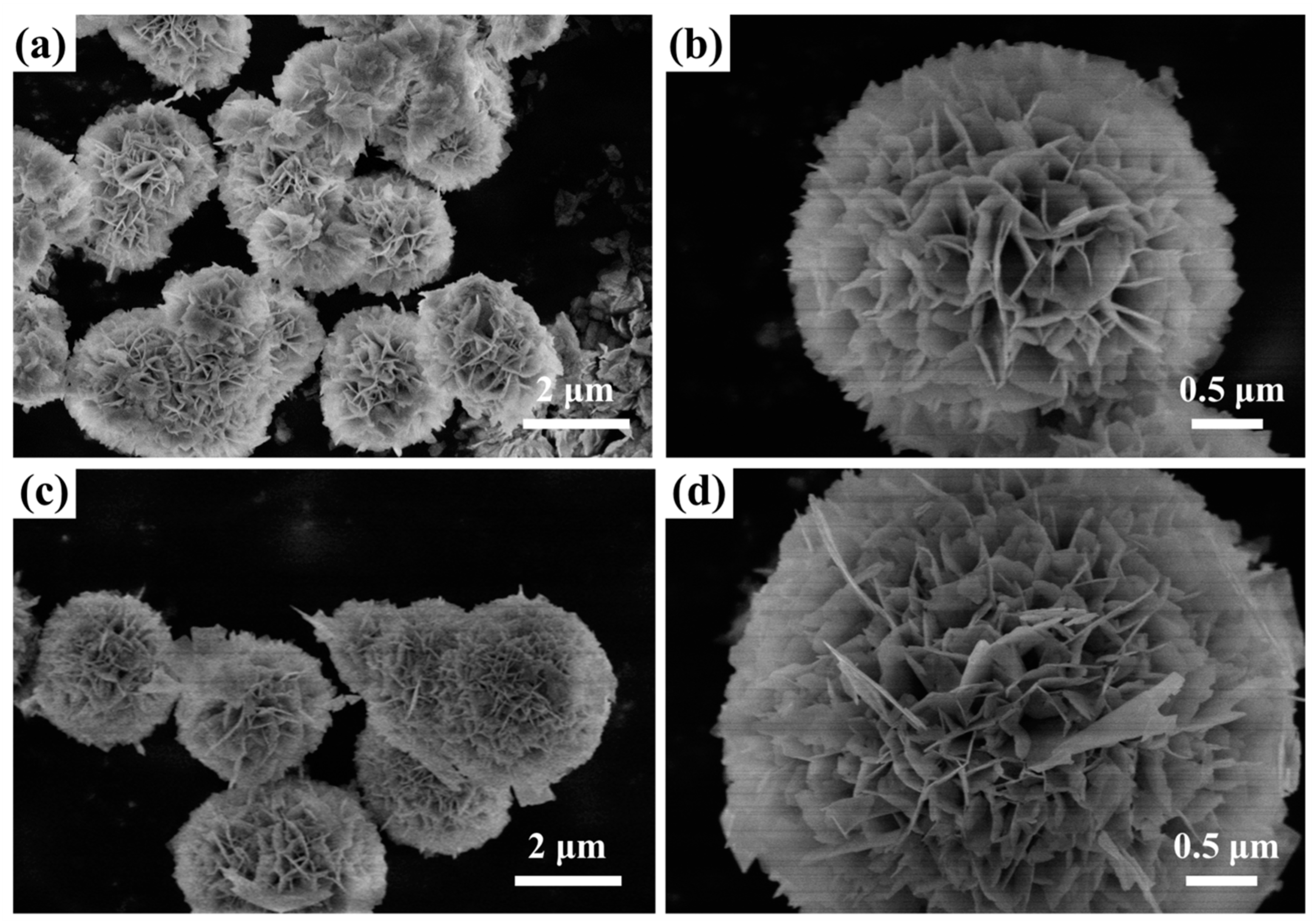
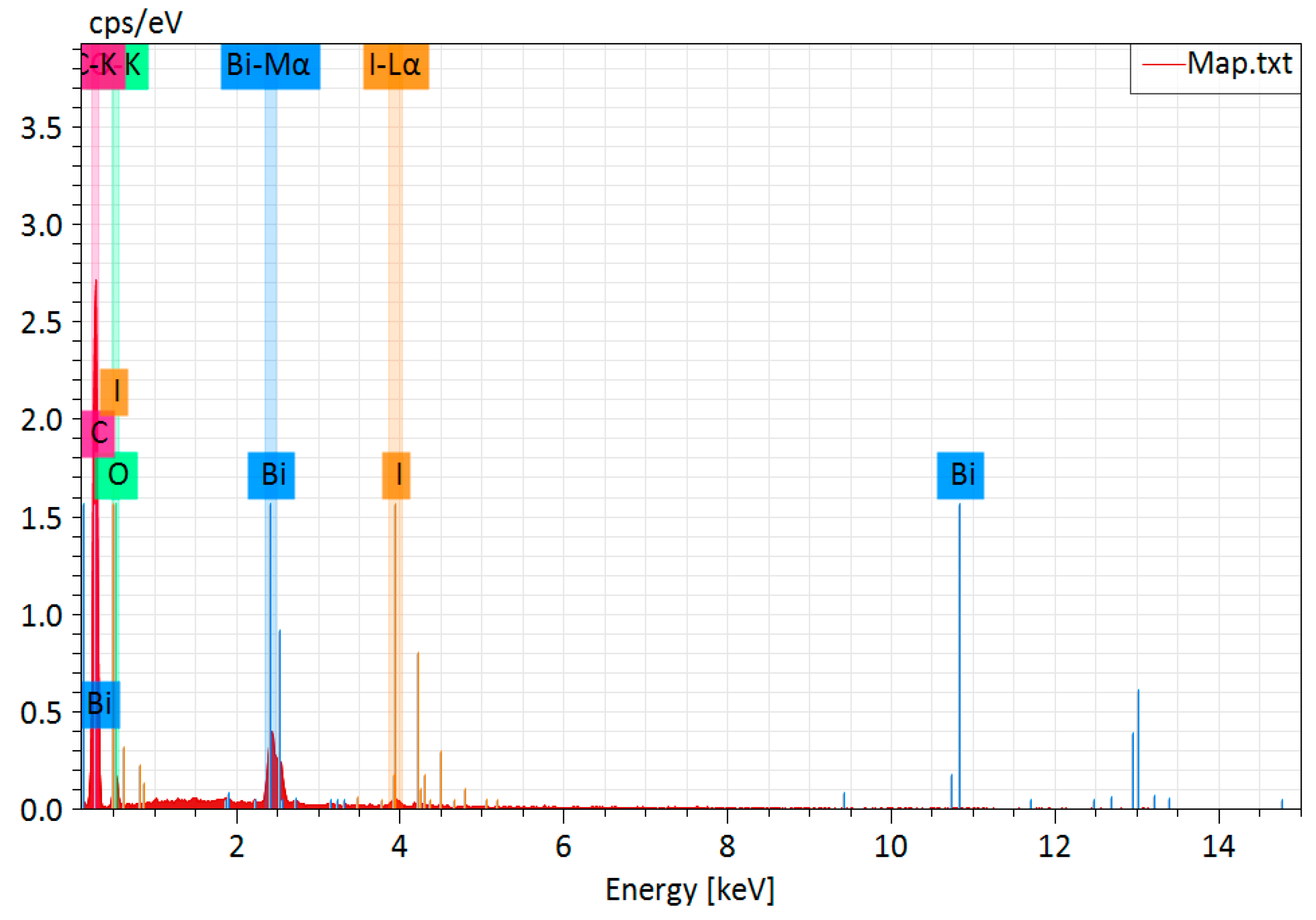
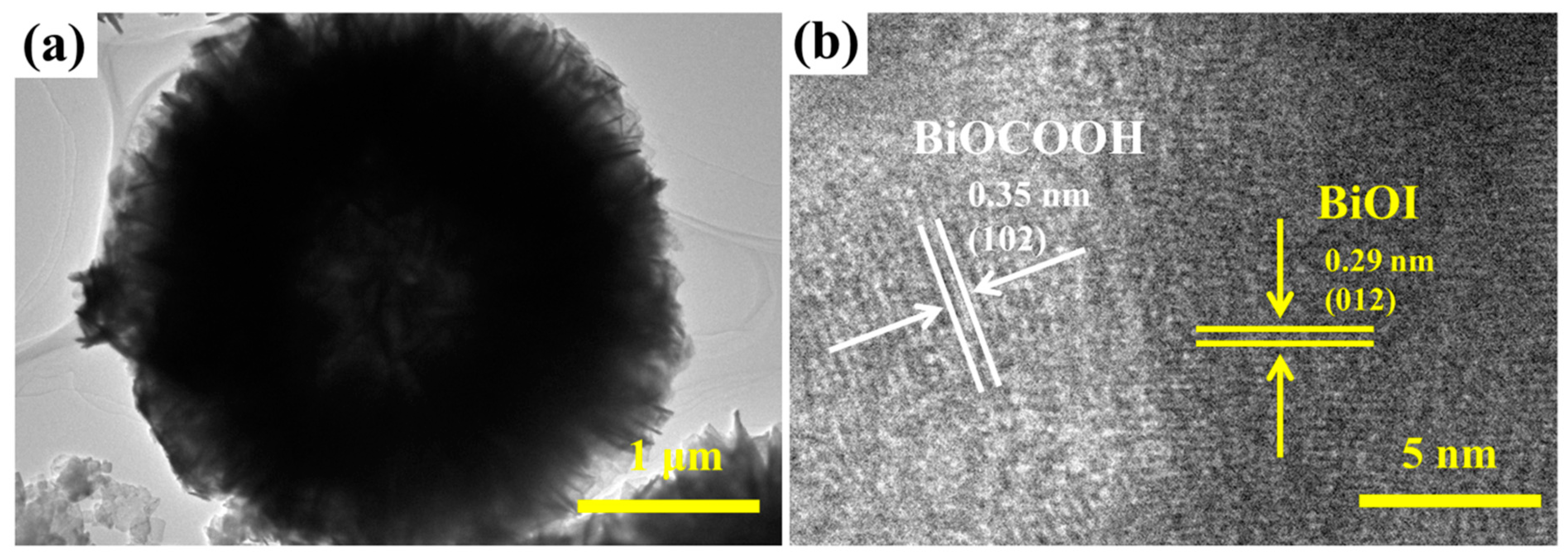
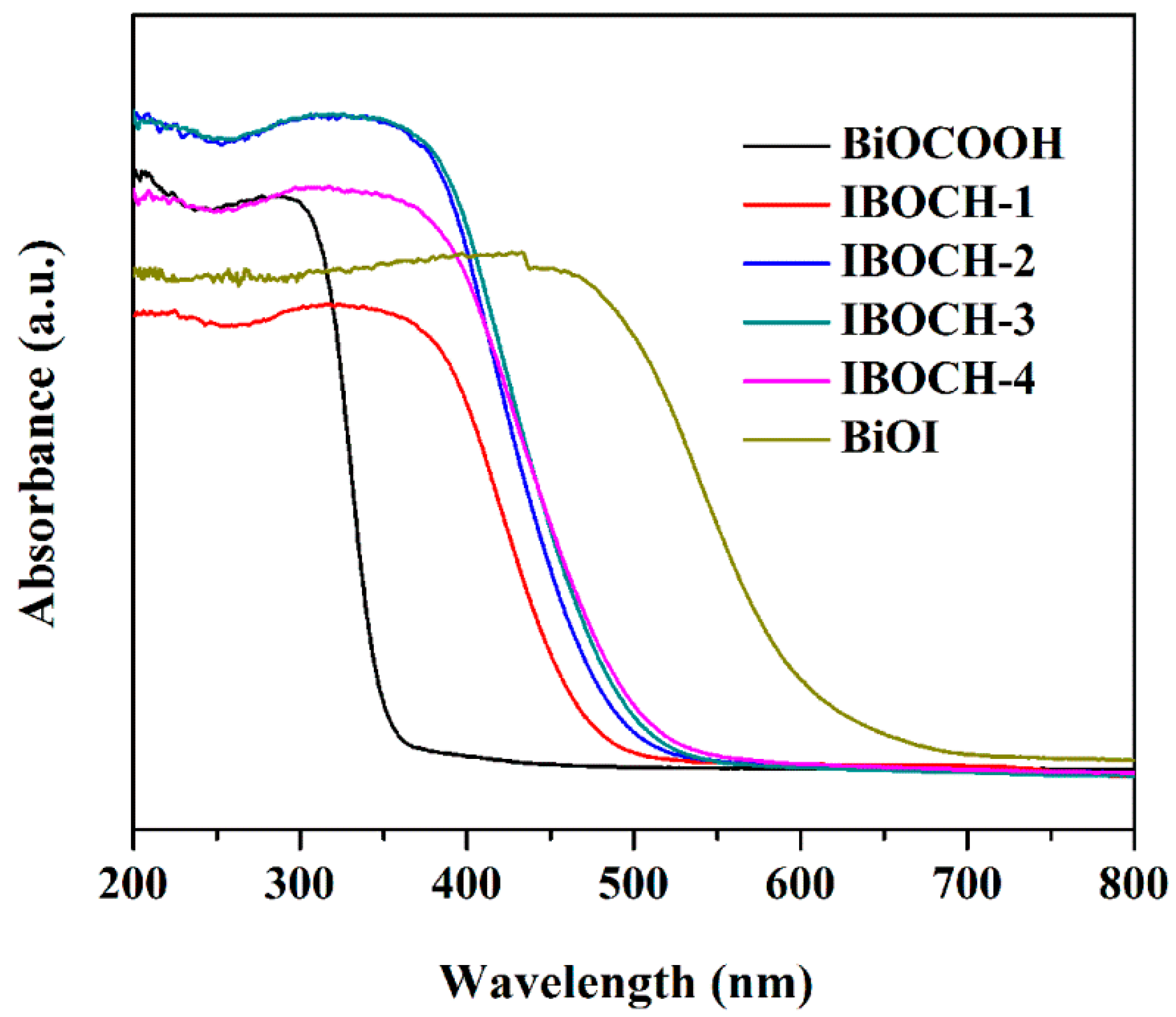


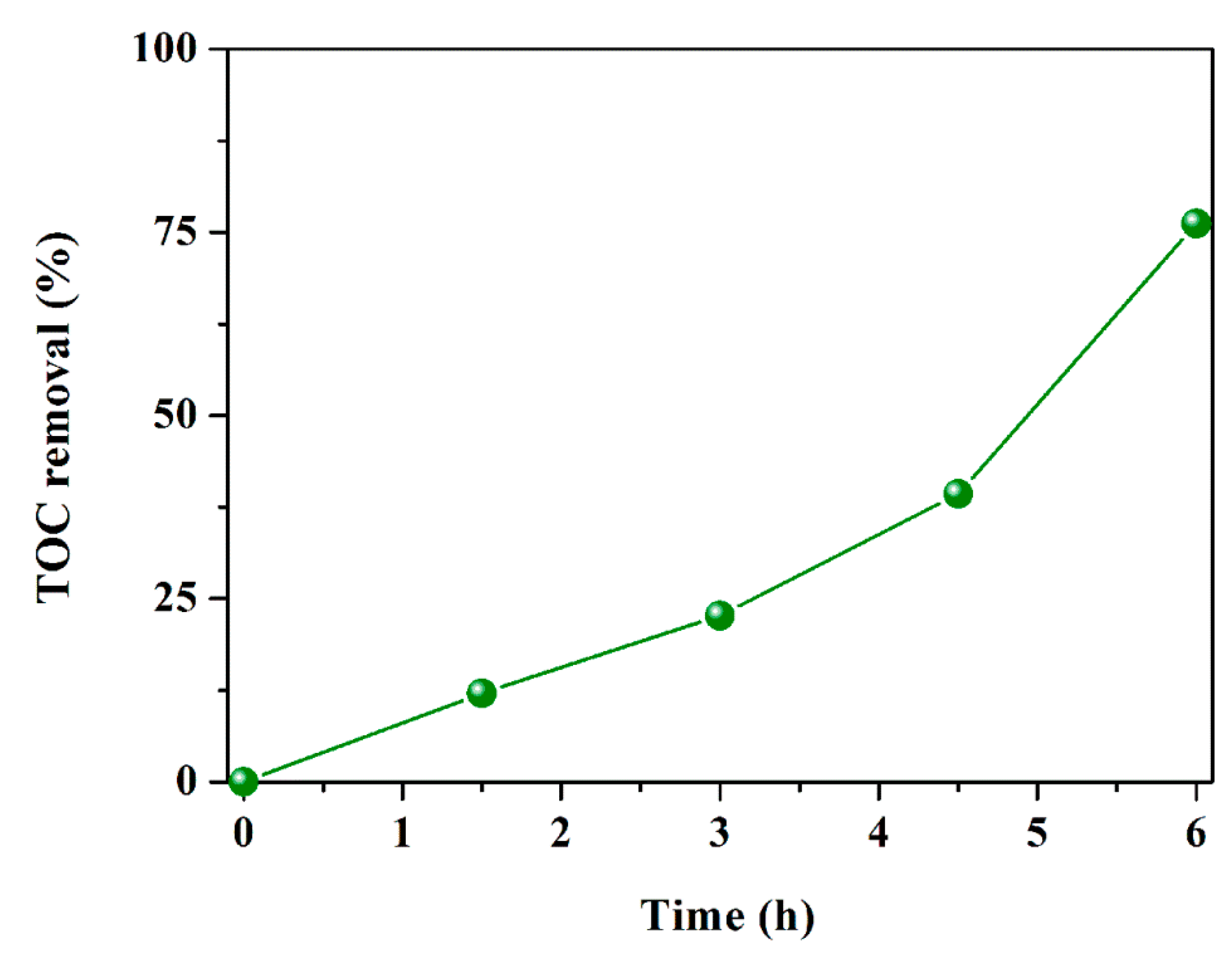


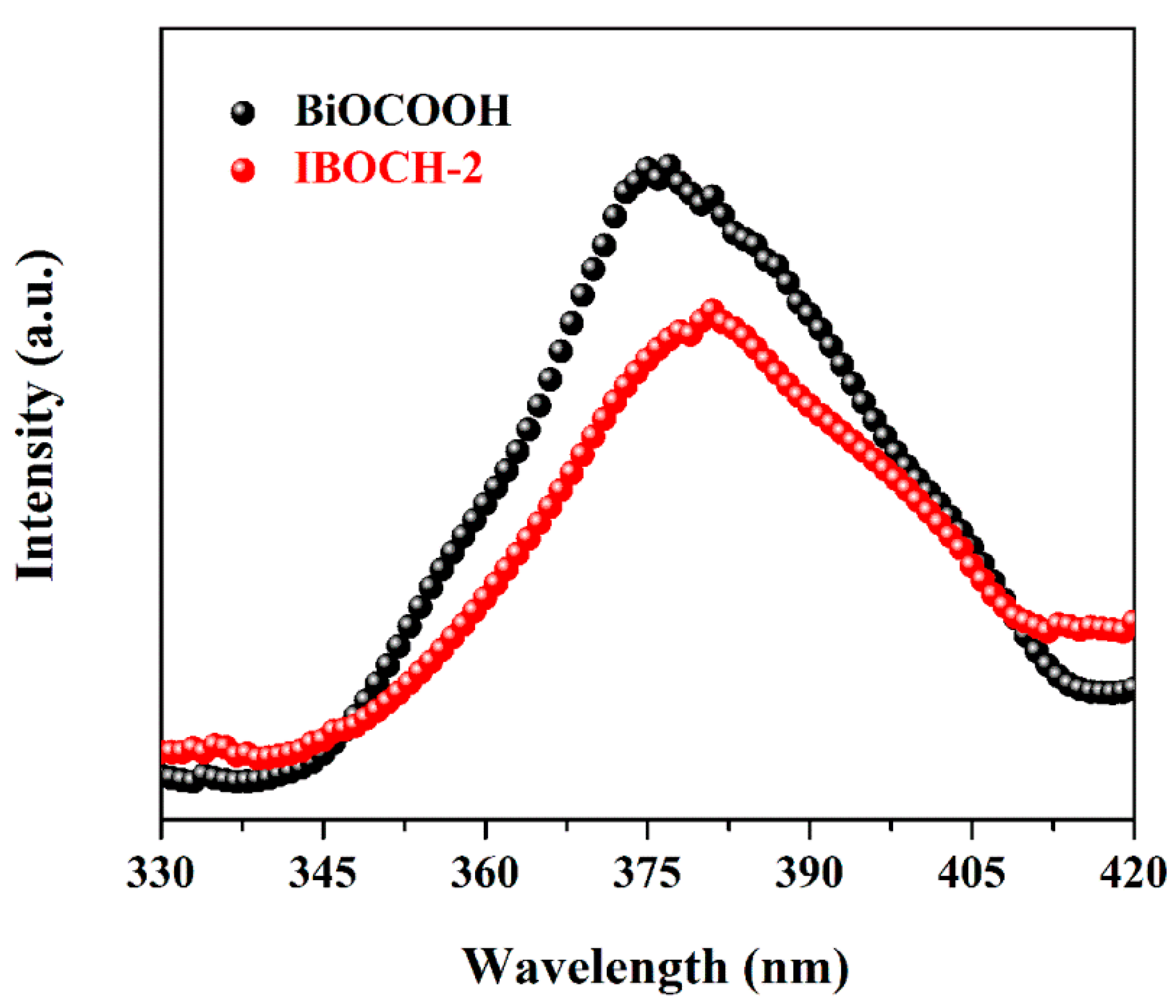
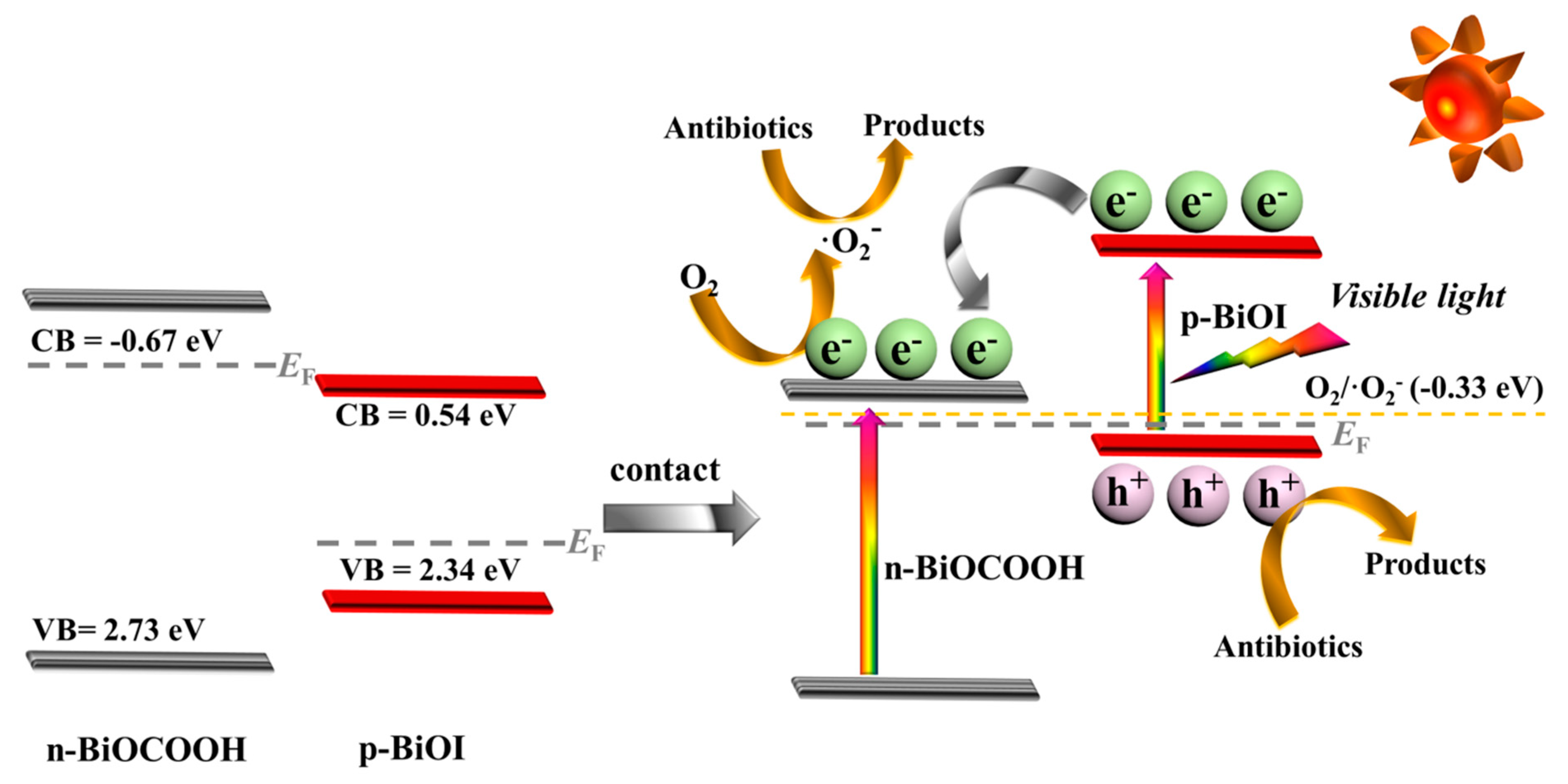
© 2019 by the authors. Licensee MDPI, Basel, Switzerland. This article is an open access article distributed under the terms and conditions of the Creative Commons Attribution (CC BY) license (http://creativecommons.org/licenses/by/4.0/).
Share and Cite
Li, S.; Xue, B.; Wang, C.; Jiang, W.; Hu, S.; Liu, Y.; Wang, H.; Liu, J. Facile Fabrication of Flower-Like BiOI/BiOCOOH p–n Heterojunctions for Highly Efficient Visible-Light-Driven Photocatalytic Removal of Harmful Antibiotics. Nanomaterials 2019, 9, 1571. https://doi.org/10.3390/nano9111571
Li S, Xue B, Wang C, Jiang W, Hu S, Liu Y, Wang H, Liu J. Facile Fabrication of Flower-Like BiOI/BiOCOOH p–n Heterojunctions for Highly Efficient Visible-Light-Driven Photocatalytic Removal of Harmful Antibiotics. Nanomaterials. 2019; 9(11):1571. https://doi.org/10.3390/nano9111571
Chicago/Turabian StyleLi, Shijie, Bing Xue, Chunchun Wang, Wei Jiang, Shiwei Hu, Yanping Liu, Hengwei Wang, and Jianshe Liu. 2019. "Facile Fabrication of Flower-Like BiOI/BiOCOOH p–n Heterojunctions for Highly Efficient Visible-Light-Driven Photocatalytic Removal of Harmful Antibiotics" Nanomaterials 9, no. 11: 1571. https://doi.org/10.3390/nano9111571
APA StyleLi, S., Xue, B., Wang, C., Jiang, W., Hu, S., Liu, Y., Wang, H., & Liu, J. (2019). Facile Fabrication of Flower-Like BiOI/BiOCOOH p–n Heterojunctions for Highly Efficient Visible-Light-Driven Photocatalytic Removal of Harmful Antibiotics. Nanomaterials, 9(11), 1571. https://doi.org/10.3390/nano9111571






